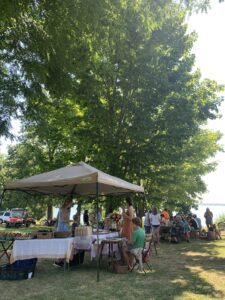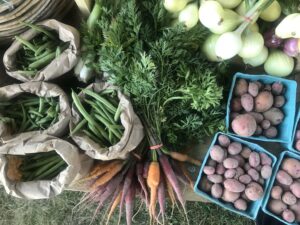Establishing a Vibrant On-Farm Market
Marketing at Red Wing Farm grew from a farm stand into a community corner-stone.
In the first segment of this three-part series, I wrote about how my partner and I established a small market garden, Red Wing Farm, as college students. In this segment I will detail how we were able to establish a vibrant market in a rural and isolated location.
Red Wing Farm is a market garden located on Grindstone Island in the St. Lawrence River. With a summer population of approximately 1,000, Grindstone Island is only accessible by boat, which significantly limits our access to markets. When we planted our first garden in the spring of 2021, our primary goal was to learn about diversified vegetable production and we had no concrete marketing strategy.

Red Wing Farm’s goal was to create a weekly community event on Saturday mornings at their farm stand. Avery MacLean / Red Wing Farm
When crops started maturing in June of our first season, we realized it was time to make a game plan. There was a small farmers market located on the mainland, in the town of Clayton, NY, and we signed up for the season. The market was supported largely by tourists who came to shop for handmade crafts and baked goods. There were three other established produce vendors at the market, who supplemented their harvest with nursery plants and produce sourced from distributors out of Syracuse, NY. It didn’t take long for us to realize that our bunches of spring greens were unable to compete with melons, peppers, and tree fruit. Not to mention that our journey to the farmer’s market was long. First, we loaded our harvest and supplies into a wagon pulled by tractor, then into the boat, then finally into our truck on the mainland. After a few weeks of schlepping and minimal sales, it was clear we needed an alternative plan.
After our unsuccessful attempt at the local farmer’s market we decided to try to sell our produce on the island, and the idea of “farm stand” was born. Despite having a substantial summer population, Grindstone Island lacks community and commercial gathering space aside from the Methodist church and a winery. Our goal was to create a weekly community event on Saturday mornings. We offered free hot coffee, a variety of baked goods, and whatever produce was available from the garden each week. We painted signs and placed them around the island. We advertised our new event at church, at the Grindstone Island Winery, and on the Island’s community Facebook page. When our first Saturday arrived, we didn’t expect anyone to come; our farm being located at the dead end of a long dirt road and folks being busy with summer activities. However, when 10 a.m. came around a slow stream of ATV’s rolled across our field. As word of mouth spread, our weekly crowd grew each week. In comparison to the farmer’s market, we were making five times the income in half the amount of time.
In addition to farm stand, we offered surplus crops to the local natural food store in Clayton, NY, the Hunner’s Market. We were fortunate to develop a friendship with the owners who understood the nuances of farming and were grateful to receive any local and organically grown produce as it was available.
As we expanded our growing space in our second season, we decided to try to expand our market for produce as well. We decided to offer a small 10-week CSA to island members available for pickup on Wednesdays. The idea is that this would add another harvest day to our schedule and teach us about another method of marketing produce. Our CSA members were offered perks such as free access to Pick Your Own flowers and herbs and 10% off produce at the Farm Stand.

Their farm stand offered whatever produce was available from the garden each week, plus free hot coffee, a variety of baked goods, and more. Avery MacLean / Red Wing Farm
In our first two seasons farming on Grindstone Island our marketing strategy for produce was fluid and evolving. Because of the nature of our location and community, we were able to establish a vibrant market and community gathering space on the farm. I attribute our success in part to the resources and strategies that were provided to us by the Cornell Small Farms Program and our local cooperative extension office. In addition, communicating with our community directly via facebook and email lists kept our customers up to date and engaged. Offering diversified and seasonal products ranging from produce to baked goods continuously drew in our customer base and allowed them to purchase much of their weekly produce on the island. Finally, we offered sliding scale pricing in order to be accessible to all members of our community.
Our marketing circumstances are no doubt unique, and we are lucky to be surrounded by a supportive and engaged community. Being able to adapt to our market and the demands of our customers has driven our success in the past two seasons.
In the final segment of this three part series, I will expand on our plans for the future and how we intend to move forward into our third growing season.

